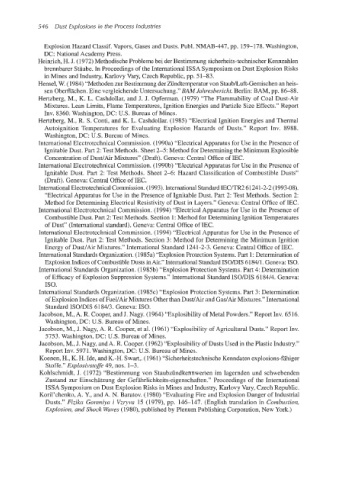Page 579 - Dust Explosions in the Process Industries
P. 579
546 Dust Explosions in the Process Industries
Explosion Hazard Classif. Vapors, Gases and Dusts. Publ. NMAB-447, pp. 159-178. Washington,
DC: National Academy Press.
Heinrich, H. J. (1972)Methodische Problemebei der Bestimmung sicherheits-technischerKennzahlen
brennbarer Staube. In Proceedings of the International ISSA Symposiumon Dust Explosion Risks
in Mines and Industry, Karlovy Vary, Czech Republic, pp. 51-83.
Hensel,W. (1984) “Methodenzur Bestimmungder Zundtemperaturvon Staubkuft-Gemischenan heis-
sen Oberflachen. Eine vergleichendeUntersuchung.”BAM Jahresbericht. Berlin: BAM, pp. 86-88.
Hertzberg, M., K. L. Cashdollar, and J. J. Opferman. (1979) “The Flammability of Coal Dust-Air
Mixtures. Lean Limits, Flame Temperatures, Ignition Energies and Particle Size Effects.” Report
Inv. 8360. Washington,DC: U.S. Bureau of Mines.
Hertzberg, M., R. S. Conti, and K. L. Cashdollar. (1985) “Electrical Ignition Energies and Thermal
Autoignition Temperatures for Evaluating Explosion Hazards of Dusts.” Report Inv. 8988.
Washington, DC: U.S. Bureau of Mines.
International Electrotechnical Commission. (1990a) “ElectricalApparatus for Use in the Presence of
Ignitable Dust. Part 2: Test Methods. Sheet 2-5: Method for Determiningthe Minimum Explosible
Concentration of Dust/Air Mixtures” (Draft). Geneva: Central Office of IEC.
International Electrotechnical Commission. (1990b) “ElectricalApparatus for Use in the Presence of
Ignitable Dust. Part 2: Test Methods. Sheet 2-6: Hazard Classification of Combustible Dusts”
(Draft). Geneva: Central Office of IEC.
International Electrotechnical Commission. (1993). International Standard IEC/TR2 61241-2-2 (1993-08).
“Electrical Apparatus for Use in the Presence of Ignitable Dust. Part 2: Test Methods. Section 2:
Method for Determining Electrical Resistivity of Dust in Layers.” Geneva: Central Office of IEC.
International Electrotechnical Commission. (1994) “Electrical Apparatus for Use in the Presence of
CombustibleDust. Part 2: Test Methods. Section 1:Method for Determining Ignition Temperatures
of Dust” (International standard). Geneva: Central Office of IEC.
International Electrotechnical Commission. (1994) “ElectricalApparatus for Use in the Presence of
Ignitable Dust. Part 2: Test Methods. Section 3: Method for Determining the Minimum Ignition
Energy of Dust/Air Mixtures.” International Standard 1241-2-3.Geneva: Central Office of IEC.
International StandardsOrganization.(1985a) “Explosion Protection Systems.Part 1:Determination of
ExplosionIndices of CombustibleDusts in&.” InternationalStandardISODIS 6184/1.Geneva:ISO.
International Standards Organization.(1985b) “ExplosionProtection Systems. Part 4: Determination
of Efficacy of Explosion Suppression Systems.” International Standard ISODIS 6 l84/4. Geneva:
ISO.
International Standards Organization.(198%) “ExplosionProtection Systems. Part 3: Determination
of Explosion Indices of Fuel/Air Mixtures Other than Dust/Air and Gas/Air Mixtures.” International
Standard lSO/DIS 6184/3. Geneva: ISO.
Jacobson, M., A. R. Cooper, and J. Nagy. (1964) “Explosibilityof Metal Powders.” Report Inv. 6516.
Washington, DC: U.S. Bureau of Mines.
Jacobson, M., J. Nagy, A. R. Cooper, et al. (1961) “Explosibility of Agricultural Dusts.” Report Inv.
5753. Washington, DC: U.S. Bureau of Mines.
Jacobson, M., J. Nagy, and A. R. Cooper. (1962) “Explosibilityof Dusts Used in the Plastic Industry.”
Report Inv. 5971. Washington, DC: U.S. Bureau of Mines.
Koenen, H., K. H. Ide, and K.-H. Swart,. (1961) “SicherheitstechnischeKenndaten explosions-f&ger
Stoffe.” Explosivstoffe 49, nos. 1-3.
Kohlschmidt, J. (1972) “Bestimmung von Staubzundkennwerten im lagernden und schwebenden
Zustand zur Einschatzung der GefSihrlichkeits-eigenschaften.”Proceedings of the International
ISSA Symposium on Dust Explosion Risks in Mines and Industry, Karlovy Vary, Czech Republic.
Koril’chenko,A. Y., and A. N. Baratov. (1980) “Evaluating Fire and Explosion Danger of Industrial
Dusts.” Fizika Goreniya i Vzryva 15 (1979), pp. 146-147. (English translation in Combustion,
Explosion, and Shock Waves (1980), published by Plenum Publishing Corporation, New York.)

